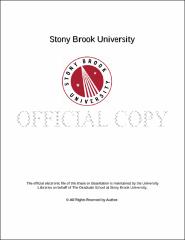| dc.identifier.uri | http://hdl.handle.net/11401/76210 | |
| dc.description.sponsorship | This work is sponsored by the Stony Brook University Graduate School in compliance with the requirements for completion of degree. | en_US |
| dc.format | Monograph | |
| dc.format.medium | Electronic Resource | en_US |
| dc.language.iso | en_US | |
| dc.publisher | The Graduate School, Stony Brook University: Stony Brook, NY. | |
| dc.type | Dissertation | |
| dcterms.abstract | The hard clam or northern quahog, Mercenaria mercenaria, is one of the most valuable seafood products in the United States. Severe episodes of hard clam mortality have been consistently associated with infections caused by a thraustochytrid parasite called Quahog Parasite Unknown (QPX). Studies in the present dissertation examined the molecular bases of QPX virulence towards clams. Investigation of QPX transcriptome libraries generated a database of QPX putative virulence factors and other molecules potentially involved in interactions with the clam host. Multiple differential gene expression profiles were generated using oligoarray technology for QPX strains isolated from different geographic locations and for parasite cells cultivated under different culture conditions (protein sources, temperature) previously shown to be important influences on parasite physiology and disease development. The transcriptomic study identified genes responsible for QPX survival and infectiveness at temperatures near the extremes of its growth range (10 °C and 27 °C). QPX cells grown in media containing clam factors exhibited a significant number of up-regulated transcripts related to stress response and detoxification. In addition, QPX cells cultivated in that media did not lead to overt disease in challenged clams suggesting that QPX exposure to clam-factors does not enhance its virulence in vivo. Comparative analysis of transcriptomic profiles of five QPX isolates originating from different geographic locations highlighted molecular adaptation of the parasite to local environmental conditions and underlined molecular mechanisms potentially involved in the variability of virulence across different strains. Bioinformatics and proteomic analyses of the molecular composition of QPX secretome revealed an array of extracellular molecules most likely to be involved in QPX infectiveness, including a variety of hydrolytic and proteolytic enzymes. Substrate-incorporated SDS PAGE gels and peptidase inhibitor studies of QPX extracellular proteolytic enzymes showed that QPX secretes mostly serine type peptidases, including subtilisin-like peptidases which digest proteins present in clam plasma, suggesting that they are directly involved in QPX virulence. The studies presented in this dissertation contribute to a better molecular characterization of QPX and could serve as a basis for future targeted investigations of QPX virulence factors. | |
| dcterms.abstract | The hard clam or northern quahog, Mercenaria mercenaria, is one of the most valuable seafood products in the United States. Severe episodes of hard clam mortality have been consistently associated with infections caused by a thraustochytrid parasite called Quahog Parasite Unknown (QPX). Studies in the present dissertation examined the molecular bases of QPX virulence towards clams. Investigation of QPX transcriptome libraries generated a database of QPX putative virulence factors and other molecules potentially involved in interactions with the clam host. Multiple differential gene expression profiles were generated using oligoarray technology for QPX strains isolated from different geographic locations and for parasite cells cultivated under different culture conditions (protein sources, temperature) previously shown to be important influences on parasite physiology and disease development. The transcriptomic study identified genes responsible for QPX survival and infectiveness at temperatures near the extremes of its growth range (10 °C and 27 °C). QPX cells grown in media containing clam factors exhibited a significant number of up-regulated transcripts related to stress response and detoxification. In addition, QPX cells cultivated in that media did not lead to overt disease in challenged clams suggesting that QPX exposure to clam-factors does not enhance its virulence in vivo. Comparative analysis of transcriptomic profiles of five QPX isolates originating from different geographic locations highlighted molecular adaptation of the parasite to local environmental conditions and underlined molecular mechanisms potentially involved in the variability of virulence across different strains. Bioinformatics and proteomic analyses of the molecular composition of QPX secretome revealed an array of extracellular molecules most likely to be involved in QPX infectiveness, including a variety of hydrolytic and proteolytic enzymes. Substrate-incorporated SDS PAGE gels and peptidase inhibitor studies of QPX extracellular proteolytic enzymes showed that QPX secretes mostly serine type peptidases, including subtilisin-like peptidases which digest proteins present in clam plasma, suggesting that they are directly involved in QPX virulence. The studies presented in this dissertation contribute to a better molecular characterization of QPX and could serve as a basis for future targeted investigations of QPX virulence factors. | |
| dcterms.available | 2017-09-20T16:49:39Z | |
| dcterms.contributor | Allam, Bassem | en_US |
| dcterms.contributor | Collier, Jackie | en_US |
| dcterms.contributor | Pales Espinosa, Emmanuelle | en_US |
| dcterms.contributor | Thanassi, David | en_US |
| dcterms.contributor | La Peyre, Jerome. | en_US |
| dcterms.creator | Rubin, Ewelina | |
| dcterms.dateAccepted | 2017-09-20T16:49:39Z | |
| dcterms.dateSubmitted | 2017-09-20T16:49:39Z | |
| dcterms.description | Department of Marine and Atmospheric Science. | en_US |
| dcterms.extent | 137 pg. | en_US |
| dcterms.format | Application/PDF | en_US |
| dcterms.format | Monograph | |
| dcterms.identifier | http://hdl.handle.net/11401/76210 | |
| dcterms.issued | 2014-12-01 | |
| dcterms.language | en_US | |
| dcterms.provenance | Made available in DSpace on 2017-09-20T16:49:39Z (GMT). No. of bitstreams: 1
Rubin_grad.sunysb_0771E_12125.pdf: 3090965 bytes, checksum: 7f1019805e1fbec87c88fc3ddc0d3c7d (MD5)
Previous issue date: 1 | en |
| dcterms.publisher | The Graduate School, Stony Brook University: Stony Brook, NY. | |
| dcterms.subject | Biology | |
| dcterms.subject | hard clam, quahog parasite, virulence | |
| dcterms.title | Molecular characterization of quahog parasite unknown (QPX), a thraustochytird pathogen of the hard clam, Mercenaria mercenaria | |
| dcterms.type | Dissertation | |

